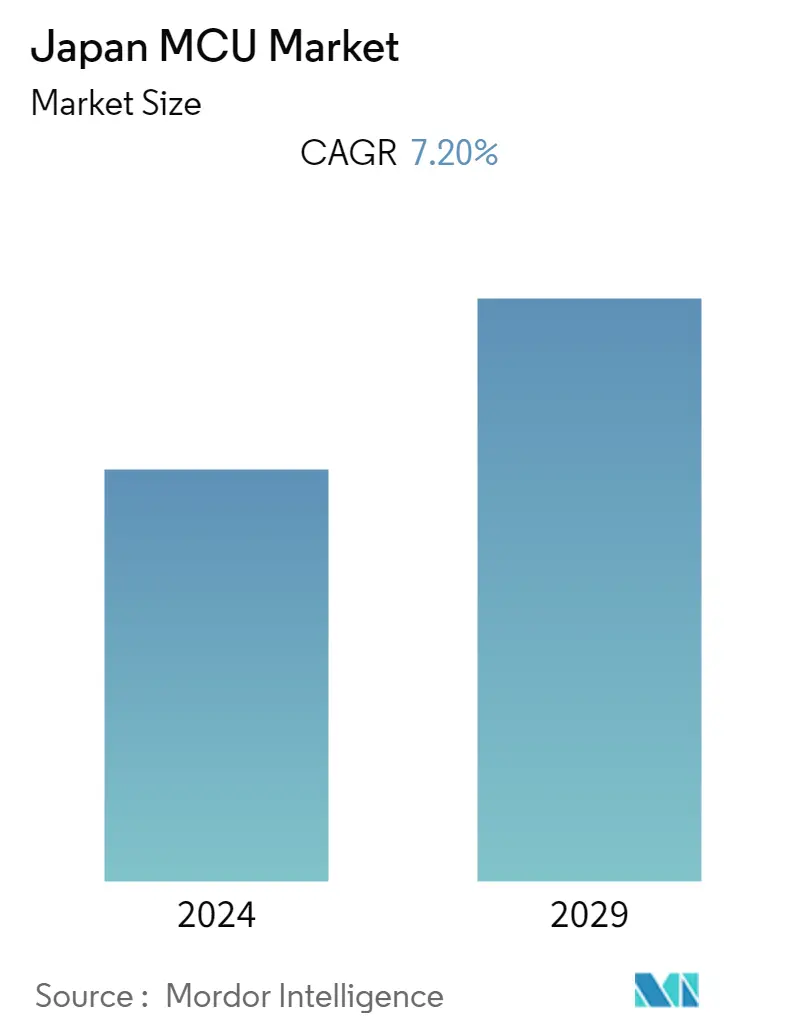Market Size of Japan MCU Industry

| Study Period | 2019 - 2029 |
| Base Year For Estimation | 2023 |
| Forecast Data Period | 2024 - 2029 |
| Historical Data Period | 2019 - 2022 |
| CAGR | 7.20 % |
| Market Concentration | Low |
Major Players_Market.webp)
*Disclaimer: Major Players sorted in no particular order |
Need a report that reflects how COVID-19 has impacted this market and its growth?
Japan MCU Market Analysis
The Japan microcontroller (MCU) market is valued at 2.87 billion in the current year and is projected to grow at a CAGR of 7.2% over the forecast period to become 4.43 billion by the next five years. Japan emerged as a significant hub for semiconductor manufacturing and semiconductor-based devices. The country has some of the most prominent electronics and automotive manufacturing companies. It contributes significantly through various applications of microcontrollers like industrial automation, automotive pharmaceutical, consumer electronics, robotics, and other end-user industries.
The rising consumer disposable income and their preferences for smart business environments and smart homes are crucial drivers for the growth of consumer electronics in Japan. Microcontrollers are used in many home appliances, such as washing machines, air conditioners, vacuum cleaners, refrigerators, motor control, front panel keypad control, analog sensor measurements, and LED/LCDs.
In addition, Japanese companies pay attention to constant innovation and upgrades to keep up with the global industrial development of microcontrollers. For instance, Renesas Electronics, a Japanese semiconductor manufacturer, has announced to invest more than 50% of its manufacturing capacity by 2023. The company will focus on producing high-end microcontrollers and other key components for automobiles and electronic devices. Renesas is targeting 40,000 200mm wafers per month by procuring more lines for outsourced production at chip foundries.
Due to COVID-19, the demand for microcontrollers has witnessed high growth in the medical device industry. As the pandemic significantly exposed Japan's lack of resilient healthcare infrastructure, higher investment in the healthcare sector is being observed, driving the adoption of advanced medical equipment and creating a favorable scenario for the studied market's growth. According to the Ministry of Health and Labor and Welfare (MLFW), Japan, the value of medical exports from the country had increased from JPY 951.53 billion (about USD 7.32 billion) in 2019 to JPY 973.38 billion (USD 7.5 billion) in 2020, and JPY 1,002.96 billion (about USD 7.7 billion) in 2021.
Fluctuating costs and a disrupted supply of raw materials are anticipated to restrain the growth of the studied market. Microcontrollers comprise several raw materials, like silicon, germanium, gallium arsenide, and silicon carbide. The increasing demand for consumer electronics and wireless communications and growing demand for energy-efficient microcontrollers factors, such as the shortage of silicon wafers coupled with the ROI metrics, will hamper the market growth.
The COVID-19 pandemic significantly impacted the Japan Microcontroller (MCU) market. The Japanese government is taking stringent measures to revive its industries, such as consumer electronics and automotive. Also, the government wishes to reduce the clustering of production facilities in one place to reduce production dependency on geographical constraints. In line with this, Japan announced a USD 2.2 billion stimulus package to help its manufacturers to shift their production facilities out of China as the pandemic disrupted the supply chain. The package specifies USD 2 billion for companies shifting production back to Japan.
